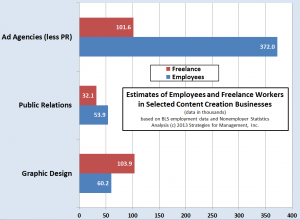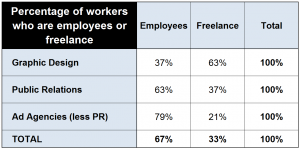Commentary & Analysis
Print Businesses in Transition Need Content Partners; Freelance Practitioners May Hold the Key to New Services
Since my TrendWatch days in the late 1990s,
Since my TrendWatch days in the late 1990s, I have always found the trends in agencies and design businesses to have implications for the print business. Back then, the increase in quality of desktop publishing software, better desktop computing platforms, and some amazing new peripherals (like drawing tablets, digital photography, and others), allowed content creators to work on their own rather than in studios. Working as a sole practitioner was not common unless you had established yourself as a superior designer. Desktop publishing and imaging changed that; at one time “freelance” meant that you were between gigs. In the late 1990s, it meant that you had a skill sought by numerous potential clients. Then the Internet bubble burst, but the trend toward freelance workers has remained. The technology and the software only got better. The need for services changed to a more diverse range of media.
Below are our estimates of employment and freelance workers for advertising, public relations, and graphic design. (click image to enlarge)
The table below summarizes the workers and sole practitioners by category. (click to enlarge)
These freelance workers often have made significant investments in computers, hardware, and software that allow them to handle routine desktop publishing, but also photo manipulation, animation, and video. They can also do their share of movie-like computer graphics for web applications.
Alliances with these practitioners can be a critical strategic step for print businesses seeking to transition their businesses to include other media. The nature of those alliances cannot be like they were in the past, where they were hired on an as-needed basis to complete a set of tasks. These content practitioners can become part of the business development process because they can provide different perspectives about client problems and a range of possible approaches using multiple media.
From a longer term view, alliances over time can lead to new business partners and co-investors as part of the adaptation a print business makes as it navigates current and future markets. Hiring for tasks is one thing; seeking a future business partner is something else. Perhaps it's time to start those kinds of discussions. As you work with content partners over 18 or 24 months it will become clear with whom to align a new business strategy.
About Dr. Joe Webb
Dr. Joe Webb is one of the graphic arts industry's best-known consultants, forecasters, and commentators. He is the director of WhatTheyThink's Economics and Research Center.
Video Center
- Inkjet driving insourcing for state in-plants
- Real World AI for the Printing Industry
- Harnessing the Power of Synergy: HP High Speed Inkjet and Indigo Liquid Toner Technologies
- KYOCERA NIXKA INKJET SYSTEMS (KNIS) INTRODUCES BELHARRA, THE NEW WAVE OF PHOTO PRINTERS
- New RISO Printing Unit Offers Easy Integration for Package Printing
- March 2024 Inkjet Installation Roundup
- Inkjet Integrator Profiles: Integrity Industrial Inkjet
- Revisiting the Samba printhead

WhatTheyThink is the official show daily media partner of drupa 2024. More info about drupa programs
© 2024 WhatTheyThink. All Rights Reserved.










